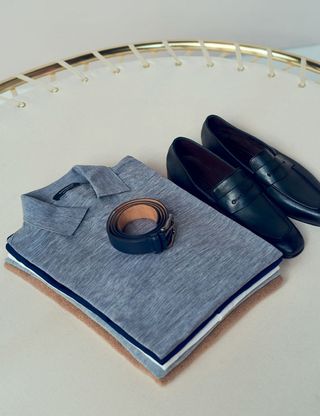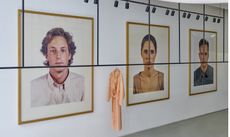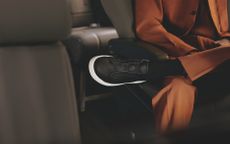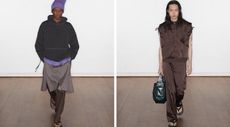Lighten up: Ermenegildo Zegna weighs in with a travel-friendly collection

Arriving this month in Ermenegildo Zegna stores worldwide is a capsule collection of 23 pieces called 'Second Skin', the first set delivered with artistic director Alessandro Sartori’s signature.
'Second Skin' is trans-seasonal, designed and engineered for year-round use. According to Sartori, it has ‘volume but no weight, so you can travel and feel almost nude’. The garments offer high comfort, exceptional performance and help regulate the body as it moves from indoor to outdoor environments – between planes, cars, trains and transport terminals, and from one climate to the next.
With a palette of vicuña, off-white, teal, brown, navy and light grey, the look sits comfortably between tailoring and sportswear, but with precision detailing so considered that you will never feel underdressed or overdressed. The fit is slim, and details are discreet. Take the rib on the knits and blouson: look closely and you will see a herringbone pattern. Minimal leather trims add interest but never weight or bulk.
Key pieces include the bomber in waterproof wool and silk, a garment Sartori describes as superleggera (super-light), explaining that even the collar is cut from a single layer of cloth. The fabric weighs just 180g per metre and the finished jacket only 470g. This piece, like others in the 'Second Skin' collection, benefits from the years of experience of Lanificio Zegna, the company’s own mill. The blouson has a detachable hood and is made from vitellina, an exceptionally soft vegetable-tanned calf leather. It’s finished as a micro nabuk, which Sartori says is ‘halfway between a classic nabuk and nappa, so the pello, or “hair”, is very short and super soft’. Of all the pieces, this is the one that needs to be touched to be believed.
Although fully tailored, a two-button blazer in garment-dyed cashmere and silk has a natural shoulder so it fits like a glove. The trousers are described by Sartori as ergonomic and the cotton has a mano fredo, or ‘cool hand’. They ‘feel fresh but very light’, the designer says, and the extra-compact weave reduces creasing.
Sartori also waxes lyrical about the polos, which have no buttons but instead a round neck with a collar. ‘The yarn is high performance,’ he says. ‘Specially selected extra-long fibres are given an extra twist.’ The crew-neck knitwear, which comes with a small nabuk leather sweatshirt detail, is made from a cashmere and silk mix that looks almost like towelling. The softness of cashmere combined with the crispness of silk is like ‘having sweet and salty at the same time’, says Sartori.
The collection’s ultra-light, calf-soled nappa moccasins have a reverse construction, whereby the upper and lining are stitched to a flexible leather sole on the reverse side and then turned inside out, which means they can be folded in half for packing.
Last summer, Sartori was installed as Ermenegildo Zegna’s first artistic director, with responsibility across all its brands. In many ways, he was coming home. The son of a seamstress, Sartori was born in Biella, just a valley away from Ermenegildo Zegna’s home town of Trivero. He spent eight years at the company, designing 'Z Zegna', followed by five years as artistic director of Berluti in Paris, before returning to the fold.
Sartori enthuses about the company’s vertical production, as he gets to eliminate weight at every stage: in the yarn and fabric development, as well as the construction of each piece. Most 'Second Skin' garments have crease-proof qualities. As a rule, crease-proof clothing is chemically treated, but Ermenegildo Zegna works in a different way. It selects only the longest fibres and develops a very high twist at yarn stage, allowing for minimal creasing in the final garment.
Sartori has already air-tested some pieces himself, including on a trip that took in wintry New York and sunny Los Angeles. As a frequent flyer, he has trained himself to reduce volume. For weekend travel, he packs just one change of clothes, plus essential tech such as noise-cancelling headphones. For longer trips, he organises his wardrobe into small poplin bags made by his mother. He demonstrates how he folds his jackets inside out for optimal packing; he recommends quickly unpacking and hanging tailoring over a bath filled with hot water, so the steam can work through the fibres.
The entire 'Second Skin' collection of 18 pieces (two blousons, one bomber, two blazers, two sweatshirts, two shirts, two long-sleeved polos, three short-sleeved polos, one pair of trousers and three five-pocket pairs of jeans) weighs just 7.2kg. And if you pack one of the five pairs of shoes, it’s just 280 grams more. A case of less but better.
As originally featured in the April 2017 issue of Wallpaper (W*217)

Jumper, £940; polo shirt, £275; top, £395; shirt, £290; top, £395; shoes, £570, all Ermenegildo Zegna ’Second Skin’ capsule collection. Belt, £270, by Ermenegildo Zegna
INFORMATION
’Second Skin’ is in stores now. For more information, visit the Ermenegildo Zegna website
Wallpaper* Newsletter
Receive our daily digest of inspiration, escapism and design stories from around the world direct to your inbox
Also known as Picky Nicky, Nick Vinson has contributed to Wallpaper* Magazine for the past 21 years. He runs Vinson&Co, a London-based bureau specialising in creative direction and interiors for the luxury goods industry. As both an expert and fan of Made in Italy, he divides his time between London and Florence and has decades of experience in the industry as a critic, curator and editor.
-
 The moments fashion met art at the 60th Venice Biennale
The moments fashion met art at the 60th Venice BiennaleThe best fashion moments at the 2024 Venice Biennale, with happenings from Dior, Golden Goose, Balenciaga, Burberry and more
By Jack Moss Published
-
 Crispin at Studio Voltaire, in Clapham, is a feast for all the senses
Crispin at Studio Voltaire, in Clapham, is a feast for all the sensesNew restaurant Crispin at Studio Voltaire is the latest opening from the brains behind Bistro Freddie and Bar Crispin, with interiors by Jermaine Gallagher
By Billie Brand Published
-
 Vivienne Westwood’s personal wardrobe goes up for sale in landmark Christie’s auction
Vivienne Westwood’s personal wardrobe goes up for sale in landmark Christie’s auctionThe proceeds of ’Vivienne Westwood: The Personal Collection’, running this June, will go to the charitable causes she championed during her lifetime
By Jack Moss Published
-
 The best fashion moments at Milan Design Week 2024
The best fashion moments at Milan Design Week 2024Scarlett Conlon discovers the moments fashion met design at Salone del Mobile and Milan Design Week 2024, as Loewe, Hermès, Bottega Veneta, Prada and more staged intriguing presentations and launches across the city
By Scarlett Conlon Published
-
 Men’s Fashion Week S/S 2025: what Wallpaper* knows so far
Men’s Fashion Week S/S 2025: what Wallpaper* knows so farThe first details of Men’s Fashion Week S/S 2025 have been announced, including appearances from Paul Smith and Marine Serre at Pitti Uomo. In an ongoing round-up, here’s everything that Wallpaper* knows so far
By Jack Moss Published
-
 New Byredo store opens in London’s Covent Garden
New Byredo store opens in London’s Covent GardenByredo has unveiled a new Covent Garden store, its second bricks-and-mortar destination in London
By Hannah Tindle Published
-
 How Biba’s make-up and cosmetics line started a beauty revolution
How Biba’s make-up and cosmetics line started a beauty revolutionAhead of a new Biba retrospective opening at London’s Fashion & Textile Museum, Hannah Tindle speaks to Barbara Hulanicki about its pioneering make-up and cosmetics line
By Hannah Tindle Published
-
 Alaïa unites fashion and art in its redesigned London flagship
Alaïa unites fashion and art in its redesigned London flagshipConceived by creative director Pieter Mulier, Alaïa’s reopened New Bond Street flagship is an intimate space which doubles as an art gallery showcasing works from Sarah Lucas, Sterling Ruby, Marc Newson and more
By Tianna Williams Published
-
 Zegna’s innovation-filled ‘Secondskin’ sneaker began with a pair of leather gloves
Zegna’s innovation-filled ‘Secondskin’ sneaker began with a pair of leather glovesZegna’s ‘Triple Stitch Secondskin’ sneaker sees the Italian house experiment with glove leather for a lightweight shoe, designed to mould to the contours of the foot
By Tianna Williams Published
-
 AV Vattev is the London-based menswear brand creating slow fashion with a subcultural twist
AV Vattev is the London-based menswear brand creating slow fashion with a subcultural twistPart of Sarabande: The Lee Alexander McQueen Foundation, Antonio Vattev of AV Vattev is staunch in his commitment to slow fashion, even as he stacks up stockists and famous fans
By Joe Bobowicz Published
-
 Cult men’s grooming brand Horace opens its first London flagship store
Cult men’s grooming brand Horace opens its first London flagship storeMen’s grooming brand Horace has unveiled its first standalone international store outside of its home in France
By Hannah Tindle Published